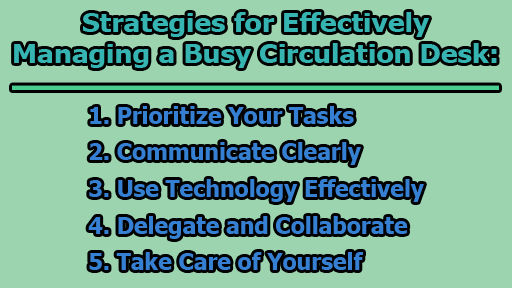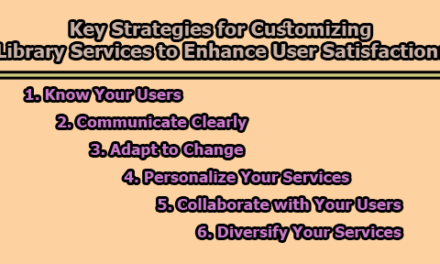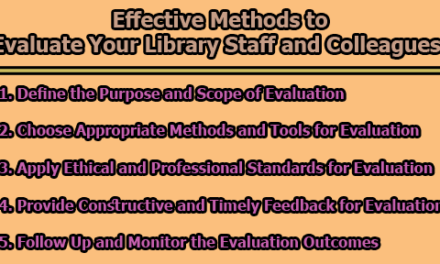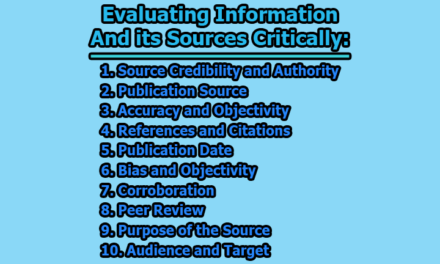Strategies for Effectively Managing a Busy Circulation Desk:
Managing a busy circulation desk at a library can be a demanding yet fulfilling role. It places you at the forefront of serving patrons, offering information, ensuring efficient operations, and promoting library resources. To excel in this dynamic position, you need to prioritize tasks, communicate effectively, utilize technology, collaborate with your colleagues, and most importantly, take care of your physical and mental well-being. In this article, we’ll explore these strategies for effectively managing a busy circulation desk.
1. Prioritize Your Tasks: When managing a busy circulation desk, one of the first steps is to prioritize your tasks effectively. You’re likely to have various responsibilities, such as checking in and out materials, renewing items, issuing library cards, and answering patron inquiries. To manage this workload, consider using the Eisenhower matrix. This technique categorizes tasks into four groups: urgent and important, important but not urgent, urgent but not important, and neither urgent nor important.
Focus on tasks that fall into the “urgent and important” category first, as these demand immediate attention. Then, plan for important but non-urgent tasks. Delegate or automate any tasks that are urgent but not important, and minimize or eliminate those that fall into the “neither urgent nor important” category. Prioritization ensures that you can manage your workload efficiently and avoid feeling overwhelmed.
2. Communicate Clearly: Clear communication is a cornerstone of successful circulation desk management. You serve as a vital point of contact for patrons, staff, and stakeholders, and effective communication can make all the difference. Practice active listening, ask pertinent questions, provide accurate information, and demonstrate empathy and respect. Your body language, tone of voice, and facial expressions can also impact how your message is received.
To communicate clearly, use simple and direct language, steer clear of jargon and slang, and repeat or summarize key points to confirm understanding. Invite feedback from patrons, be polite and courteous, and don’t hesitate to apologize if you make a mistake or cause inconvenience. Clear communication not only helps patrons but also fosters a positive atmosphere at the circulation desk.
3. Use Technology Effectively: Technology can be a valuable asset in managing a busy circulation desk. It streamlines processes, enhances access to information, and facilitates communication with patrons and staff. Some essential technology tools include a library management system (LMS) for circulation tasks, self-service kiosks to reduce wait times, barcode scanners to minimize errors, and a phone system to handle calls efficiently.
Computers or tablets provide access to the library’s catalog and online resources, while printers or copiers can be used for various administrative tasks. To use technology effectively, it’s crucial to choose the right tools, keep them up-to-date and secure, and be prepared to troubleshoot any issues that may arise. Technology can significantly improve your efficiency and the overall patron experience.
4. Delegate and Collaborate: Managing a busy circulation desk doesn’t have to be a solitary endeavor. Delegating tasks and collaborating with colleagues, supervisors, and volunteers can help distribute the workload, enhance efficiency, and promote teamwork. Effective delegation and collaboration start with identifying tasks that can be delegated or shared and determining the right people for the job.
Provide clear instructions, set expectations, and offer feedback to those you delegate or collaborate with. Respect their skills, opinions, and preferences, and maintain open communication to address any conflicts or issues that may arise. Recognizing and appreciating their contributions is essential to maintaining a positive working environment.
5. Take Care of Yourself: Finally, while managing a busy circulation desk can be rewarding, it can also be physically and mentally taxing. To prevent burnout and fatigue, maintaining a healthy work-life balance is crucial. Incorporate regular breaks into your day to relax or engage in activities you enjoy. Ensure that you’re eating well, staying hydrated, getting sufficient sleep, and following a consistent sleep schedule.
Regular exercise and stress management techniques such as breathing exercises, meditation, or hobbies can also help maintain your physical and mental well-being. Don’t hesitate to seek support from trusted friends, family members, coworkers, or counselors if you find yourself struggling.
In conclusion, managing a busy circulation desk is a challenging yet rewarding role, and it requires a combination of effective strategies and self-care to succeed. By prioritizing tasks, communicating clearly, utilizing technology, delegating and collaborating, and taking care of your well-being, you can excel in your role, provide excellent customer service, and enjoy the work. These tips will help you navigate the demands of the job and create a positive and productive atmosphere at the circulation desk.

Assistant Teacher at Zinzira Pir Mohammad Pilot School and College










